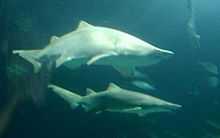L'Oceanogràfic (Valencian: [loseanoˈɣɾafik], Spanish: El Oceonográfico, "The Oceanographic") is an oceanarium situated in the east of the city of Valencia, Spain, where different marine habitats are represented. It was designed by the architect Félix Candela and the structural engineers Alberto Domingo and Carlos Lázaro. It is integrated inside the cultural complex known as the Ciutat de les Arts i de les Ciències (City of Arts and Sciences). It was opened on 14 February 2003.
General information
The Oceanographic is the largest complex of its type in Europe with a surface of 110,000 square metres (1,200,000 sq ft) and a water capacity of 42,000,000 litres (11,000,000 US gal).[1] This includes a 26,000,000-litre (6,900,000 US gal) dolphinarium and a 7,000,000-litre (1,800,000 US gal) ocean tank with sharks, rays and other fish.[1] There are 45,000 animals of 500 different species including fish, mammals, birds, reptiles and invertebrates — amongst these are sharks, penguins, dolphins, sea lions, walruses, beluga whales, and more — all inhabiting nine underwater towers. Each tower is structured in two levels and represent the major ecosystems of the planet.
The park is divided into ten areas. The marine areas reflect the Mediterranean habitats, the polar oceans — the Arctic, the islands, the tropical seas, the temperate seas and the Red Sea. The park also includes a dolphinarium, an auditorium with a Red Sea aquarium, an area of mangrove swamps and marshland, and a garden with more than 80 different species of plant.
The sea water is pumped from the beach of La Malva-Rosa having passed all of the necessary requirements for quality.
The architecture of the complex is a work of the architect Félix Candela and the engineers Alberto Domingo and Carlos Lázaro, who made the structural design of the concrete coverings of the buildings.
Articles and other references
External links



